Experimental and Numerical Research of Post-Tensioned Concrete Beams
Abstract
:1. Introduction
2. Experimental Research
2.1. Post-Tensioned Concrete Beams
2.2. Loading and Testing Program
2.3. Structural Materials Testing
2.3.1. Concrete
2.3.2. Prestressing Steel
2.4. Reinforcement Steel Bars
2.5. Stand and Method for Strength Testing of the Beams
2.6. Results of the Experimental Research of Strength Testing of the Beams
3. Numerical Models of the Post-Tensioned Concrete Beams
3.1. Numerical Model Description
3.2. FE Mesh Details
3.3. Materials Models Definition
3.3.1. Prestressing Steel
- Elastic strength limit;
- Lower yield limit equal to the tensile strength at 0.1% permanent plastic strain;
- Upper yield limit;
- Ultimate tensile strength.
3.3.2. Steel Components
3.3.3. Concrete
3.3.4. True Stress—Strain Relationships
3.4. Contact Definition
3.5. Explicit Solving Procedure
3.5.1. Dynamic Equilibrium Equation for Static Problems Analysis
3.5.2. Damping Parameters
3.5.3. Dilatation Wave Velocity and Critical Time Step
3.5.4. Prestressing Force Value
3.5.5. The Method of Applying the External Load
4. Results of the Numerical Research
4.1. Comparative Analysis of the Numerical and Experimental Results for the Force—Displacement Relationship
4.2. Numerical Analysis of Beams Behaviour
4.3. Discussion on Imperfections Analysis
4.3.1. Location of Damage Initiation
4.3.2. Local Concentrations of Stresses
5. Conclusions
- Precise preparation of experimental models of post-tensioned concrete beams and careful execution of experimental tests allowed the avoidance of unintentional model imperfections and the obtainment of appropriate results;
- The use of a separate finite element for modelling each material component of each beam: concrete, prestressing steel, reinforcing steel and anchorages, with appropriate modelling of contact interactions, results in a damage simulation qualitatively similar to the results of experimental tests. Initial cracks in the concrete occur at the location of stirrups and then develop into larger damage with new cracks between the stirrups;
- The convergence of the numerical solution is closely related to the precise modelling of the finite element geometry system. Elements in the finite element mesh should be made as square as possible to avoid numerical effects, i.e., shear locking and volume locking. The proposed meshing of the model allowed the avoidance of the numerical hourglass effect. The use of the reduced integration method for 3D hexahedral finite elements was sufficient to obtain a convergent solution, which is more efficient than other methods in terms of computational time. The applied meshing did not cause differences in the results between the incompatible modes and the reduced mode of the integration methods;
- The explicit procedure is an effective method for modelling post-tensioned concrete beams with different curvilinear tendon systems under static loading. With the ap-propriate calibration of the numerical model in relation to a detailed analysis of the experimental damage mechanism, the presented approach allows for the modelling of various geometries of post-tensioned beams. The proposed loading procedure in explicit solution method, based on an application of the loading velocity equal to 0.025% of the fastest dilatation wave velocity, gave a convergent solution for analysed post-tensioned beams without model oscillations and the local jetting effect. The beam models were calibrated to experimental results with the Rayleigh mass-damping parameter ;
- An appropriate simulation of concrete damage was obtained on the basis of the description of concrete material softening with a model of concrete damage plasticity. The inclusion of residual stresses in the concrete model ensured an increase in the ductility of the concrete material in interaction with the steel reinforcement to enable an extended damage simulation in the FEM beam models. Taking into account the effective modulus of the elasticity of concrete with the use of the real creep coefficient ensured a reduction in the stiffness in the numerical beam models by about 44%;
- A very good agreement between the numerical results and the experimental results for beam No. 1 was obtained. The slightly lower agreement between the numerical and experimental results for beam No. 2, especially in terms of displacements, was due to random imperfections found in the experimental results. The experimentally observed nature of concrete damage mechanisms and the numerical simulations of stress and damage states of both considered beams confirmed the design assumption about the ultimate load capacity that was determined by the strength of the concrete compression zone.
Author Contributions
Funding
Institutional Review Board Statement
Informed Consent Statement
Data Availability Statement
Acknowledgments
Conflicts of Interest
References
- Noble, D.; Nogal, M.; O’Connor, A.; Pakrashi, V. The effect of prestress force magnitude and eccentricity on the natural bending frequencies of uncracked prestressed concrete beams. J. Sound Vib. 2016, 365, 22–44. [Google Scholar] [CrossRef]
- Limongelli, P.M.; Siegert, D.; Merliot, E.; Waeytens, J.; Bourquin, F.; Vidal, R.; Corvec, L.V.; Gueguen, I.; Cottineau, L.M. Damage detection in a post tensioned concrete beam—Experimental investigation. Eng. Struct. 2016, 128, 15–25. [Google Scholar] [CrossRef]
- Ng Koon, C.; Tan Hwee, T. Flexural behaviour of externally prestressed beams. Part II: Experimental investigation. Eng. Struct. 2006, 28, 622–633. [Google Scholar] [CrossRef]
- Six, P.; Tawadrous, R.; Syndergaard, P.; Maguire, M. Flexural behavior of three span continuous unbonded post-tensioned members with variable bonded reinforcement. Eng. Struct. 2019, 200, 109704. [Google Scholar] [CrossRef]
- Rawi, A.Y.; Temsah, Y.; Baalbaki, O.; Jahami, A.; Darwiche, M. Experimental investigation on the effect of impact loading on behavior of post-tensioned concrete slabs. J. Build. Eng. 2020, 31, 101207. [Google Scholar] [CrossRef]
- Kim, H.-S.; Park, Y.S.; Park, H.Y.; Jeon, J.-S. Friction characteristics of post-tensioning tendons in full-scale structures. Eng. Struct. 2019, 183, 389–397. [Google Scholar] [CrossRef]
- Szydłowski, R.; Łabuzek, B. Experimental Evaluation of Shrinkage, Creep and Prestress Losses in Lightweight Aggregate Concrete with Sintered Fly Ash. Materials 2021, 14, 3895. [Google Scholar] [CrossRef]
- Fu, C.; Zhu, Y.; Wang, Y. Stiffness assessment of cracked post-tensioned concrete beams with unbonded tendons based on the cracking pattern. Eng. Struct. 2020, 214, 110599. [Google Scholar] [CrossRef]
- Kim, K.S.; Lee, D.H. Nonlinear analysis method for continuous post-tensioned concrete members with unbonded tendons. Eng. Struct. 2012, 40, 487–500. [Google Scholar] [CrossRef]
- Kang, T.H.-K.; Huang, Y.; Shin, M.; Lee, J.D.; Cho, A.S. Experimental and Numerical Assessment of Bonded and Unbonded Post-Tensioned Concrete Members. ACI Struct. J. 2015, 112, 735–748. [Google Scholar] [CrossRef]
- Hafezolghorani, M.; Hejazi, F.; Vaghei, R.; Saleh Bin Jaafar, M.; Karimzade, K. Simplified Damage Plasticity Model for Concrete. Struct. Eng. Int. 2017, 27, 68–78. [Google Scholar] [CrossRef]
- Brenkus, N.R.; Tatar, J.; Hamilton, H.R.; Consolazio, G.R. Simplified finite element modelling of post-tensioned concrete members with mixed bonded and unbonded tendons. Eng. Struct. 2019, 179, 387–397. [Google Scholar] [CrossRef]
- Ellobody, E.; Bailey, C.G. Modelling of unbonded post-tensioned concrete slabs under fire conditions. Fire Saf. J. 2009, 44, 159–167. [Google Scholar] [CrossRef]
- Lee, S.-H.; Abolmaali, A.; Shin, K.-J.; Lee, H.-D. ABAQUS modelling for post-tensioned reinforced concrete beams. J. Build. Eng. 2020, 30, 101273. [Google Scholar] [CrossRef]
- Huang, Y.; Kang, T.H.-K.; Ramseyer, C.; Rha, C. Background to multi-scale modelling of unbonded Post-Tensioned concrete structures. Theor. Appl. Multiscale Mech. 2010, 1, 219–235. [Google Scholar] [CrossRef]
- Tran, D.T.; Pham, T.M.; Hao, H.; Chen, W. Numerical investigation of flexural behaviours of precast segmental concrete beams internally post-tensioned with unbonded FRP tendons under monotonic loading. Eng. Struct. 2021, 249, 113341. [Google Scholar] [CrossRef]
- Pham, T.D.; Hong, W.-K. Investigation of Strain Evolutions in Prestressed Reinforced Concrete Beams Based on Nonlinear Finite Element Analyses Considering Concrete Plasticity and Concrete Damage Plasticity. J. Asian Archit. Build. Eng. 2022, 21, 448–468. [Google Scholar] [CrossRef]
- Wang, C.; Shen, Y.; Yang, S.; Wen, Z. Ductility and Ultimate Capacity of Prestressed Steel Reinforced Concrete Beams. Math. Probl. Eng. 2017, 2017, 1467940. [Google Scholar] [CrossRef]
- Cornejo, A.; Barbu, L.G.; Escudero, C.; Martinez, X.; Oller, S.; Barbat, A.H. Methodology for the analysis of post-tensioned structures using a constitutive serial-parallel rule of mixtures. Compos. Struct. 2018, 200, 480–497. [Google Scholar] [CrossRef]
- Chroscielewski, J.; Miskiewicz, M.; Pyrzowski, L.; Sobczyk, B. Damage analysis of tensioning cable anchorage zone of a bridge superstructure using CDP Abaqus material model. Arch. Civ. Eng. 2017, 63, 3–18. [Google Scholar] [CrossRef]
- Setiawan, F.A.; Sulistyo, D.; Aminullah, A. Finite Element Method for Numerical Analysis of Post-Tension Anchorage Zone. Procedia Eng. 2014, 95, 272–278. [Google Scholar] [CrossRef]
- Huang, Y.; Kang, H.-K.T. Modeling of Sliding Behavior of Unbonded Tendons in Post-Tensioned Concrete Members. ACI Struct. J. 2018, 115, 1153–1164. [Google Scholar] [CrossRef]
- Cichorski, W.; Stolarski, A. Influence of high strength of concrete and reinforcing steel on dynamic behaviour of reinforced concrete deep beam. In Proceedings of the 12th International Conference on Shock & Impact Loads on Structures, Singapore, 15–16 June 2017; Masuya, H., Fujikake, K., Lok, T.S., Eds.; Ci-Premier Pte Ltd.: Singapore, 2017; pp. 159–168, ISBN 978-981-11-2850-9. [Google Scholar]
- Cichorski, W.; Stolarski, A. Prognosis of dynamic behavior of reinforced concrete deep beams of very high strength materials. Arch. Civ. Eng. 2020, 66, 247–279. [Google Scholar] [CrossRef]
- Stolarski, A.; Cichorski, W.; Szcześniak, A. Non-Classical Model of Dynamic Behavior of Concrete. Appl. Sci. 2019, 9, 2590. [Google Scholar] [CrossRef]
- Jancy, A.; Zychowicz, J.; Stolarski, A. Research on the damage mechanism of post-tensioned concrete beams. In Proceedings of the Scientific and Technical Conference “Prestressed Structures” KS2018, Cracow, Poland, 18–20 April 2018; Derkowski, W., Gwoździewicz, P., Pańtak, M., Politalski, W., Seruga, A., Zych, M., Eds.; Cracow University of Technology: Cracow, Poland, 2018; pp. 99–102, ISBN 978-83-941947-2-7. [Google Scholar]
- TTM Tension Technology S.r.l. TTM Monostrand System Types E and EX; European Technical Approval ETA-09/0012; Consiglio Superiore Dei Lavori Pubblici: Ceprano, Italy, 2012. [Google Scholar]
- EN 206+A1:2016-12; Concrete—Specification, Performance and Conformity. European Committee for Standardization: Brussels, Belgium, 2016.
- Jankowiak, T.; Łodygowski, T. Identification of parameters of concrete damage plasticity constitutive model. Found. Civ. Environ. Eng. 2005, 5, 53–69. [Google Scholar]
- Sumer, Y.; Aktas, M. Defining parameters for concrete damage plasticity model. Chall. J. Struct. Mech. 2015, 3, 149–155. [Google Scholar]
- Voyiadjis, G.Z.; Taqieddin, Z.N. Elastic Plastic and Damage Model for Concrete Materials: Part I—Theoretical Formulation. Int. J. Struct. Changes Solids—Mech. Appl. 2009, 1, 31–59. [Google Scholar]
- Yu, T.; Teng, J.G.; Wong, Y.L.; Dong, S.L. Finite element modeling of confined concrete-II: Plastic-damage model. Eng. Struct. 2010, 32, 680–691. [Google Scholar] [CrossRef]
- Szczecina, M.; Winnicki, A. Calibration of the CDP model parameters in Abaqus. In Proceedings of the 2015 World Congress on Advances in Structural Engineering and Mechanics (ASEM15), Incheon, Korea, 25–29 August 2015. [Google Scholar]
- EN 1992-1-1; Design of Concrete Structures: Part 1-1: General Rules and Rules for Buildings. European Committee for Standardization: Brussels, Belgium, 2004.
- Wriggers, P. Nonlinear Finite Element Methods; Springer: Berlin/Heidelberg, Germany, 2008. [Google Scholar]
- ABAQUS. ABAQUS Analysis User’s Manual, Version 6.5; Abaqus Inc.: Providence, RI, USA, 2004. [Google Scholar]
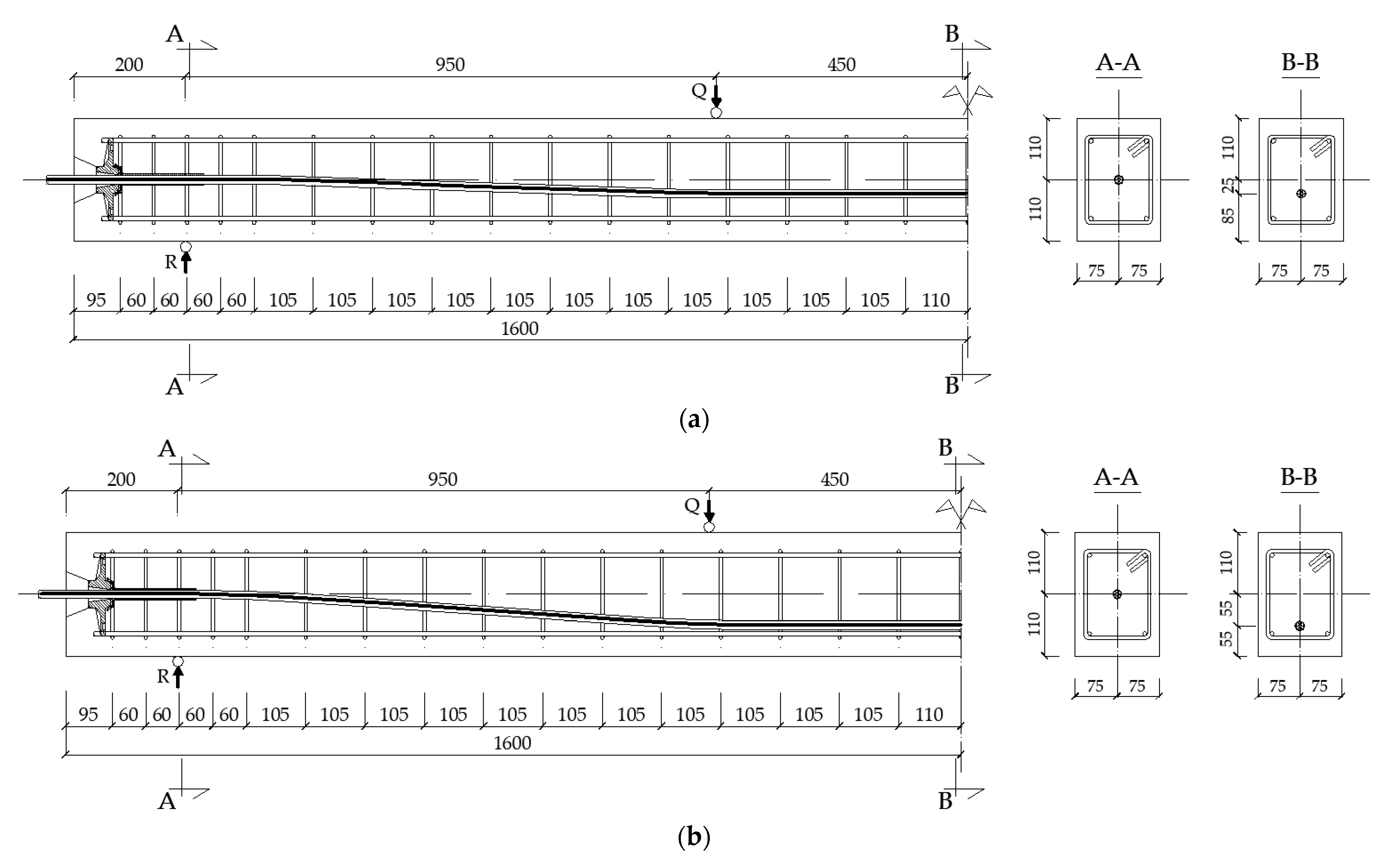
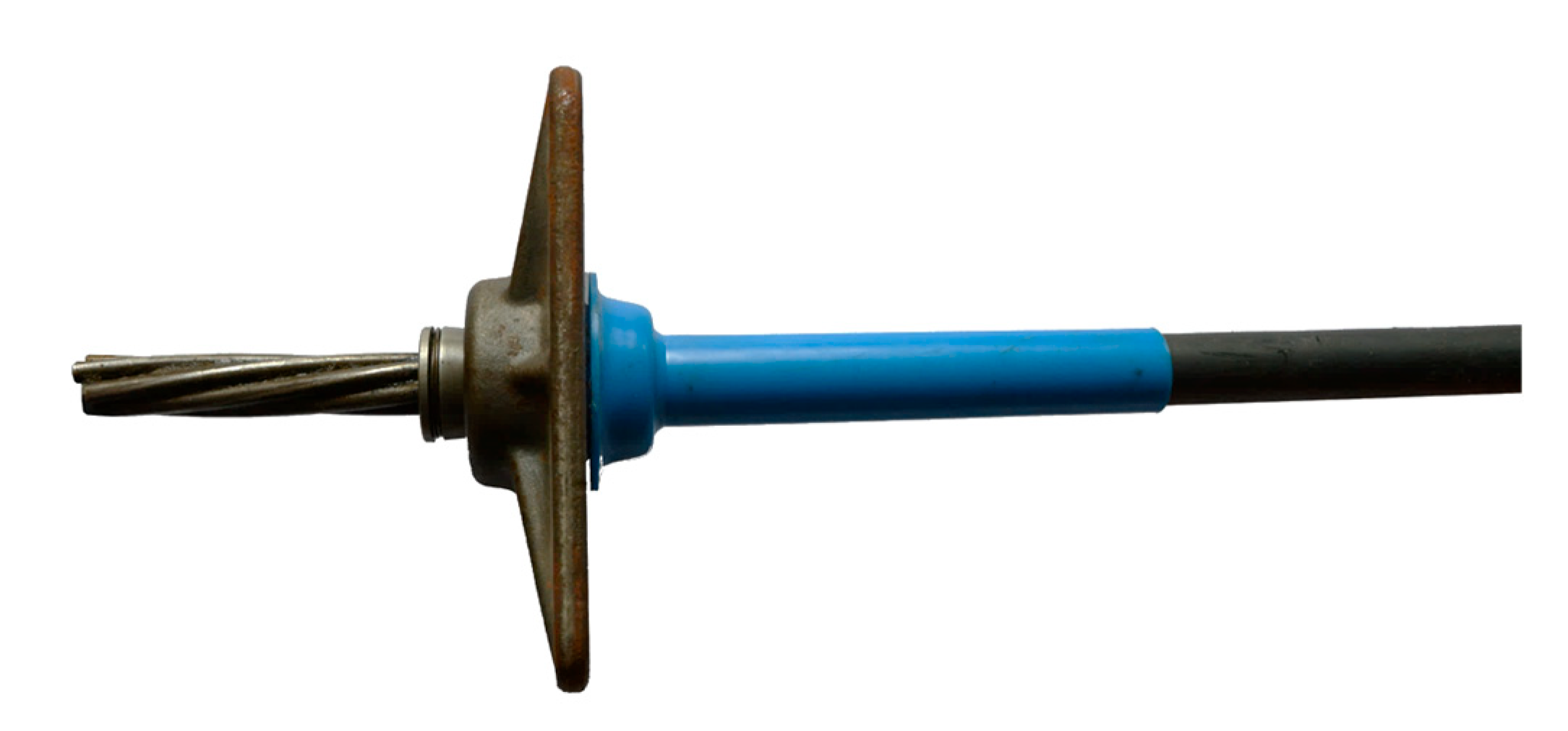


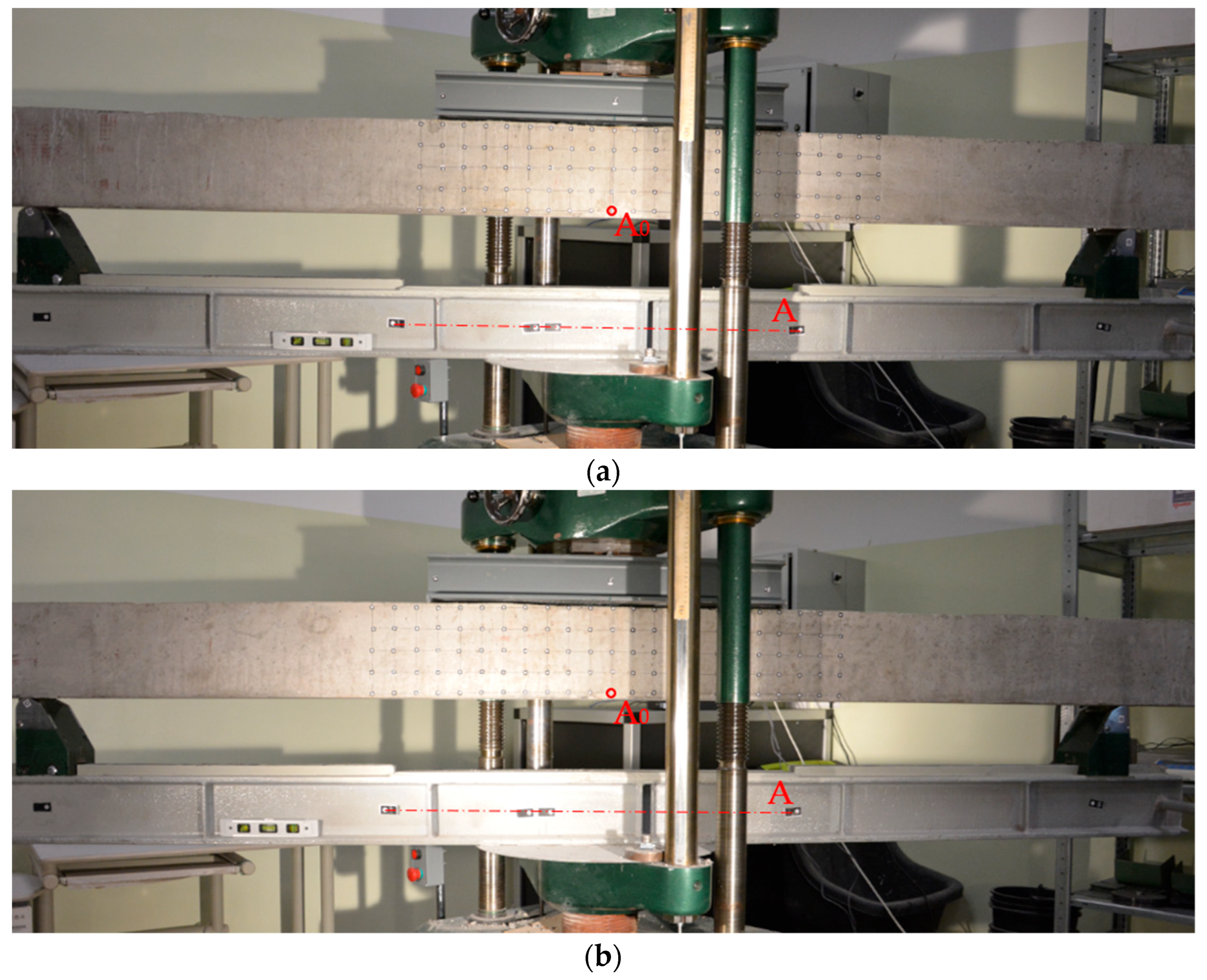

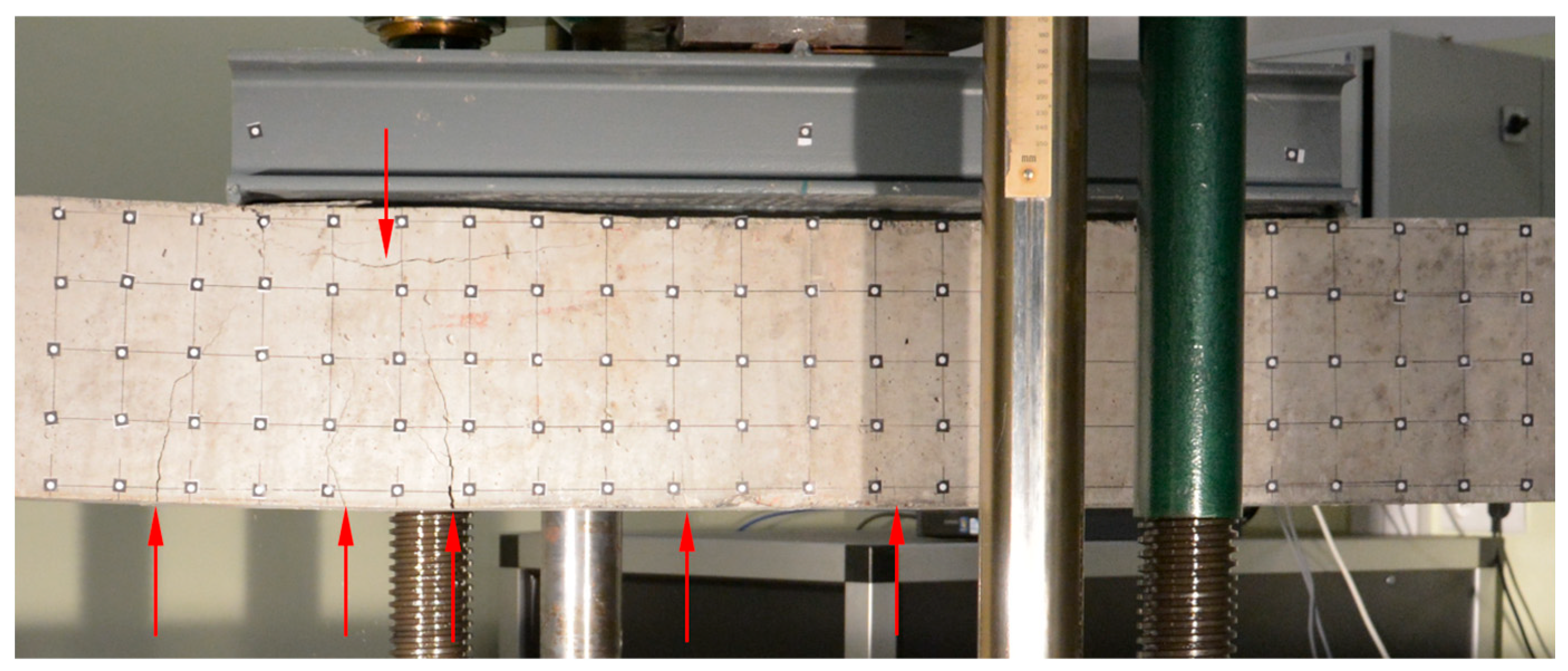
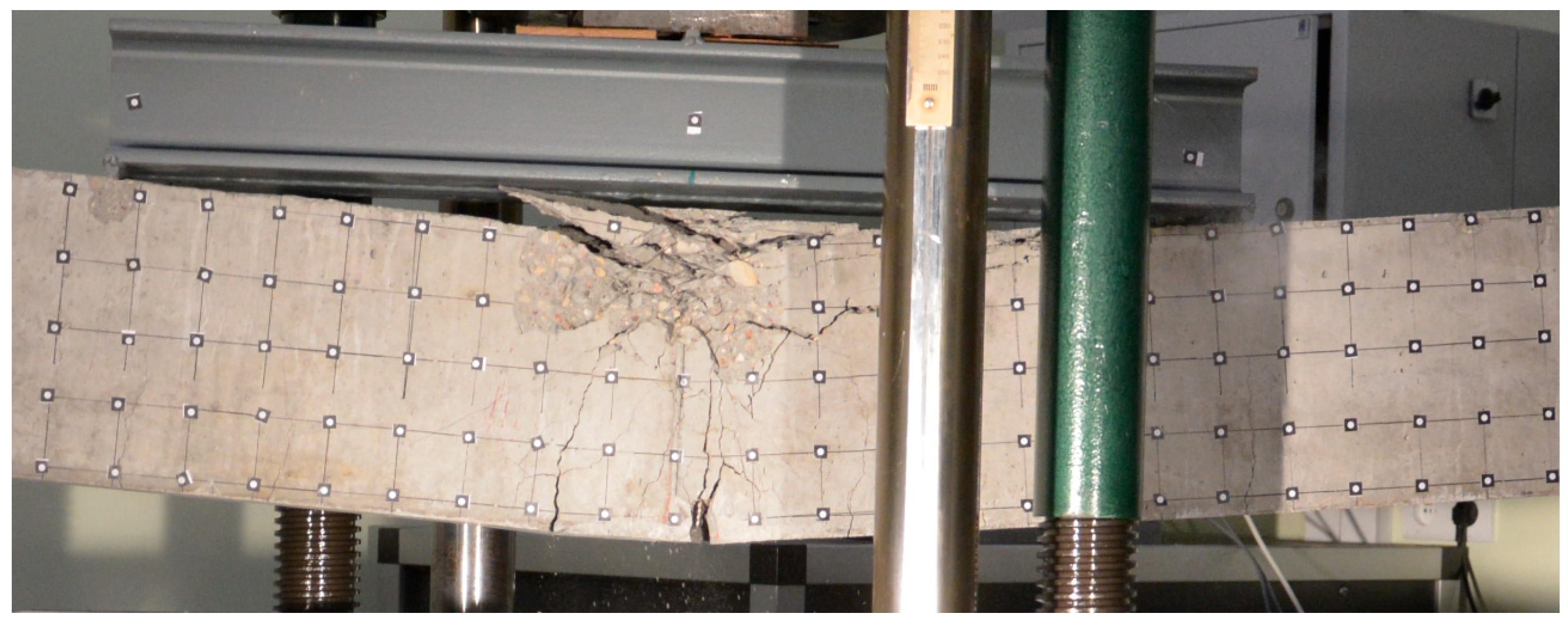
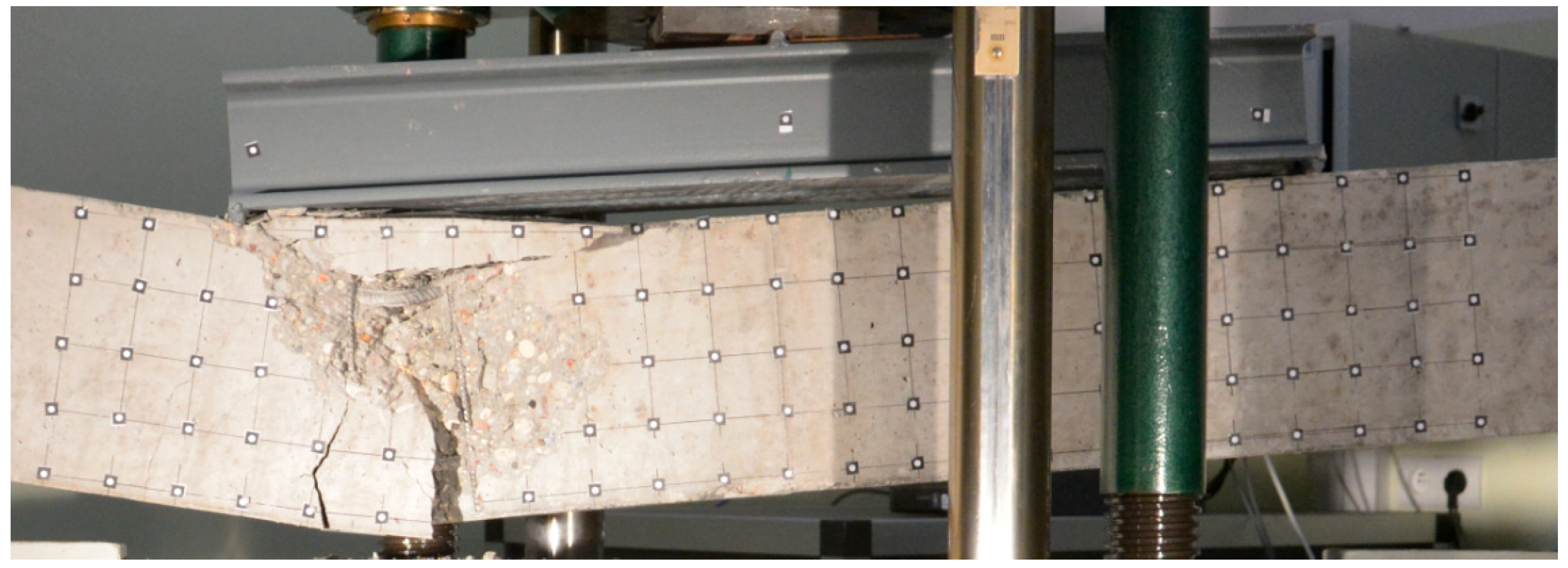
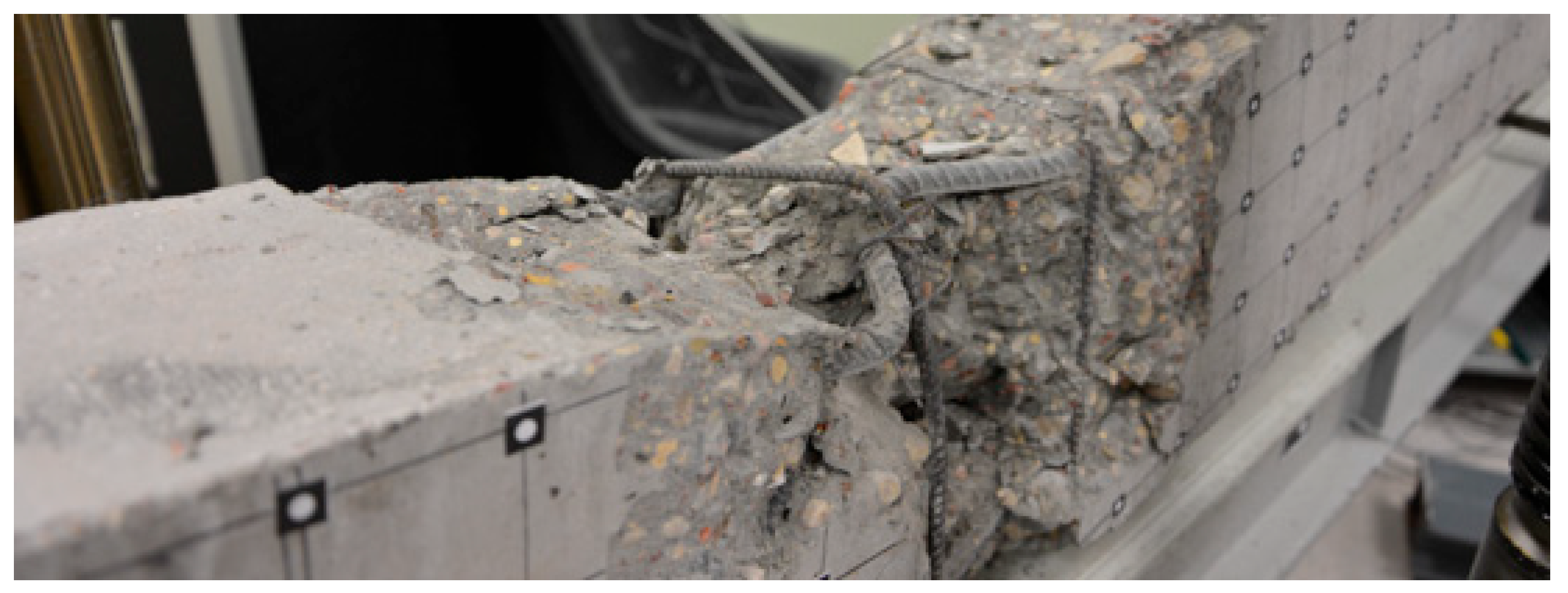

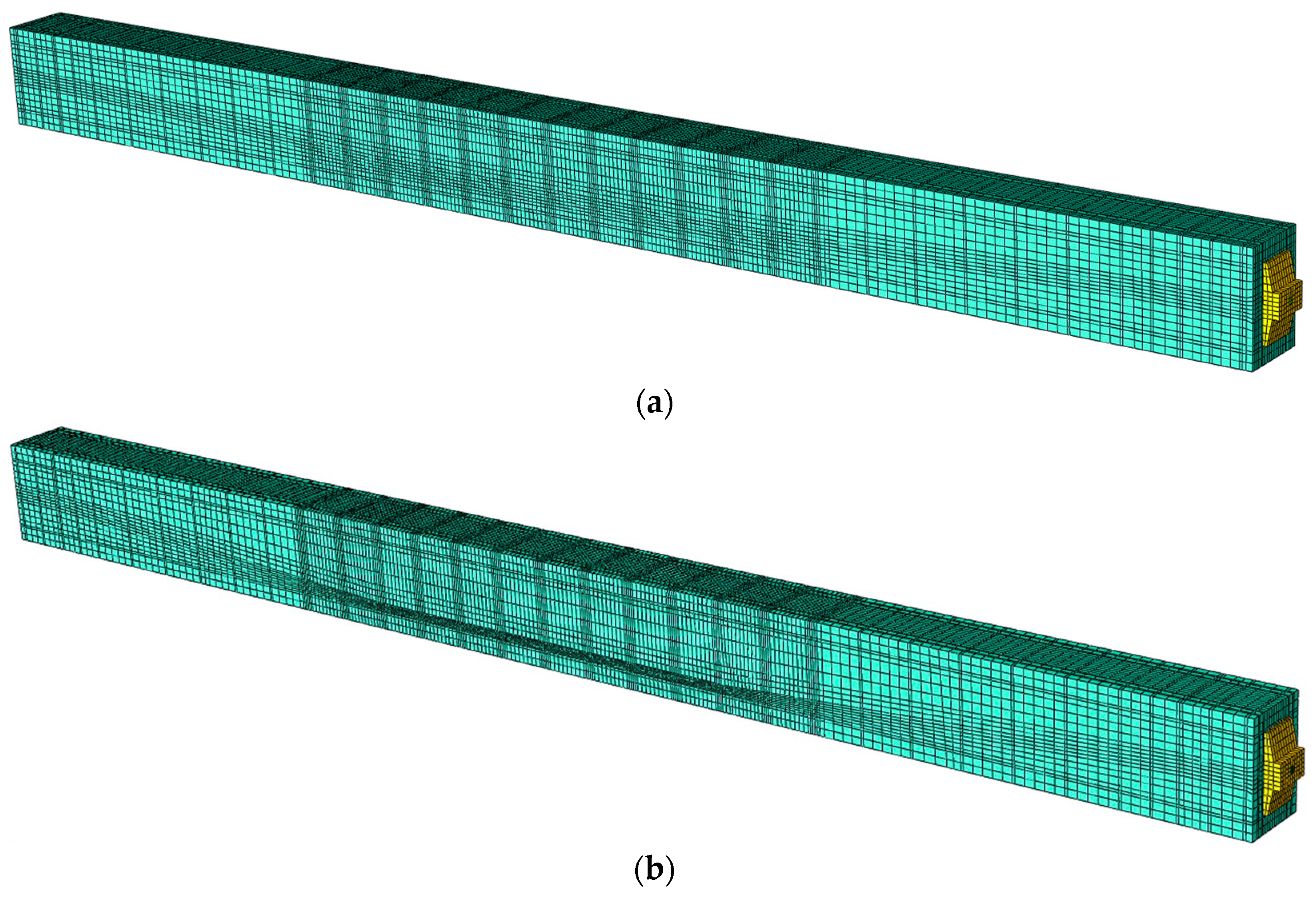
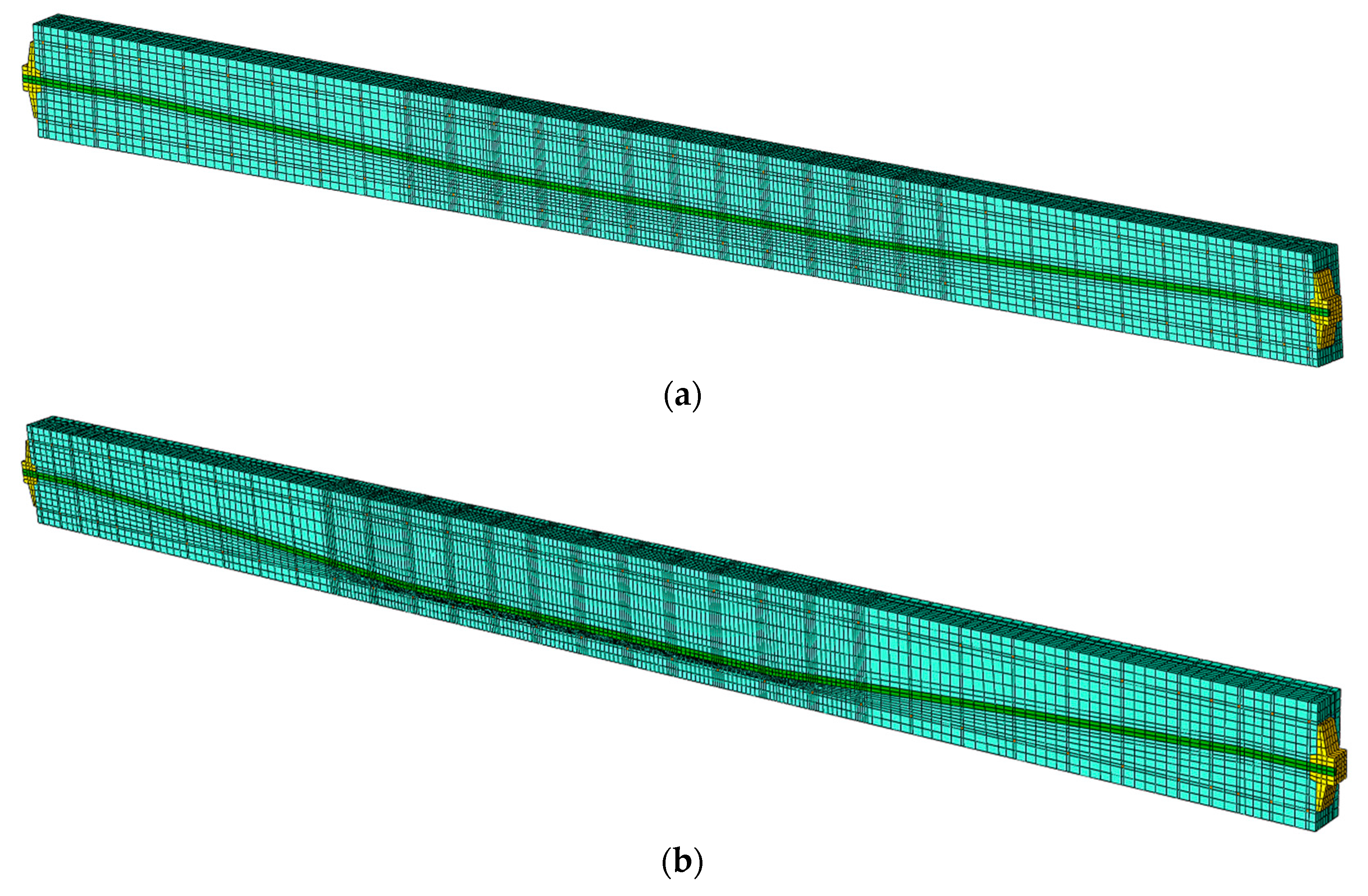


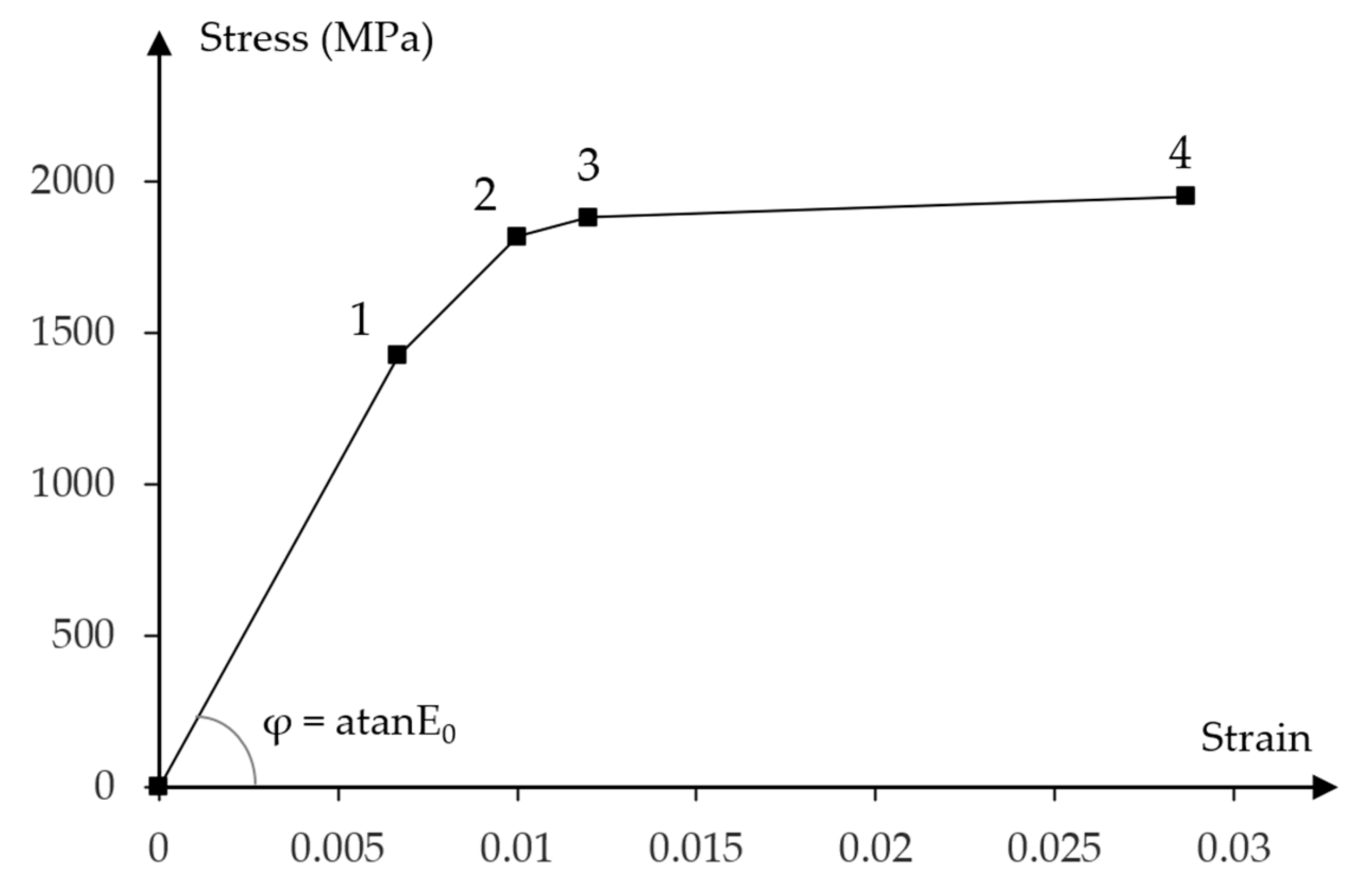

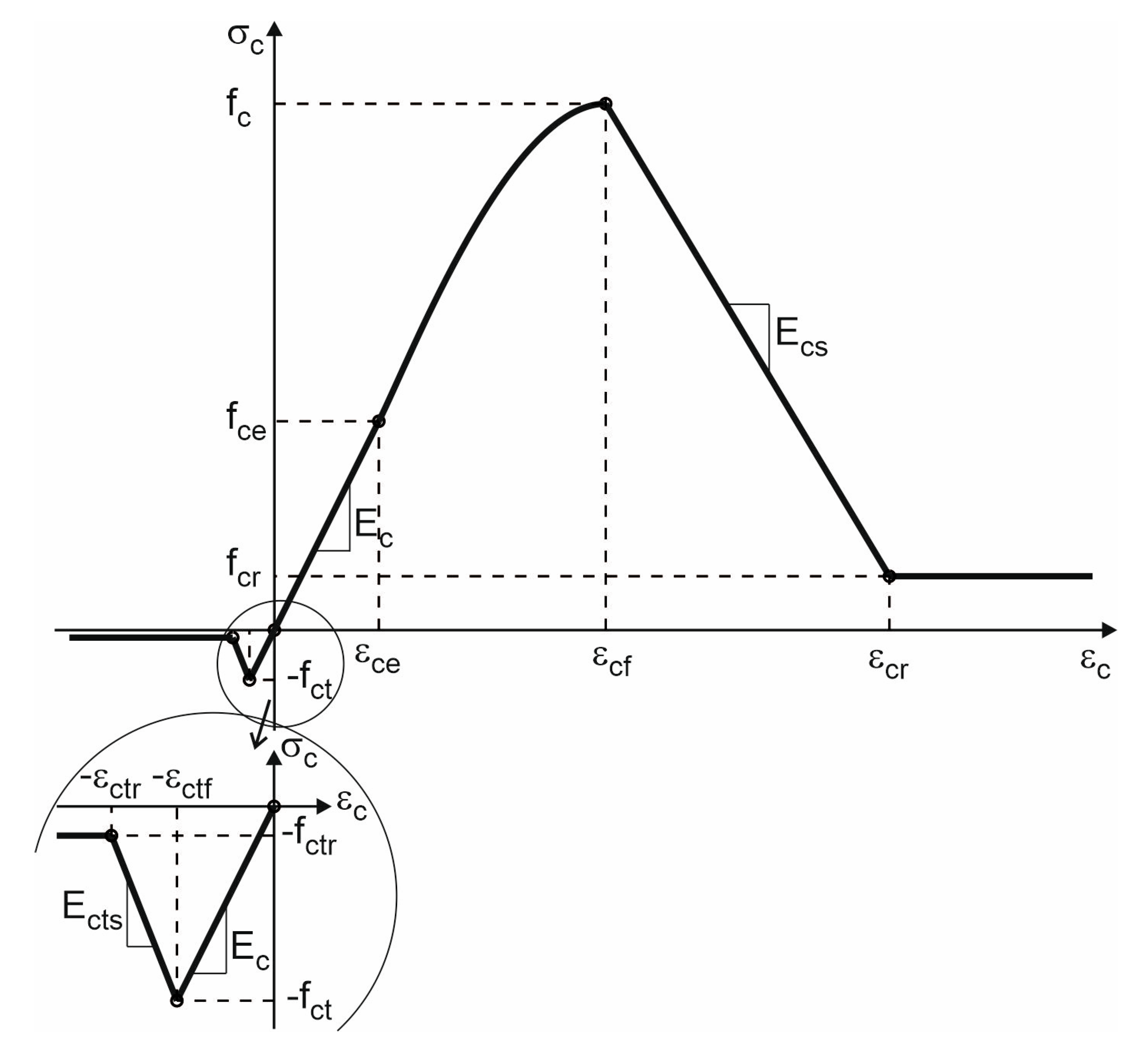
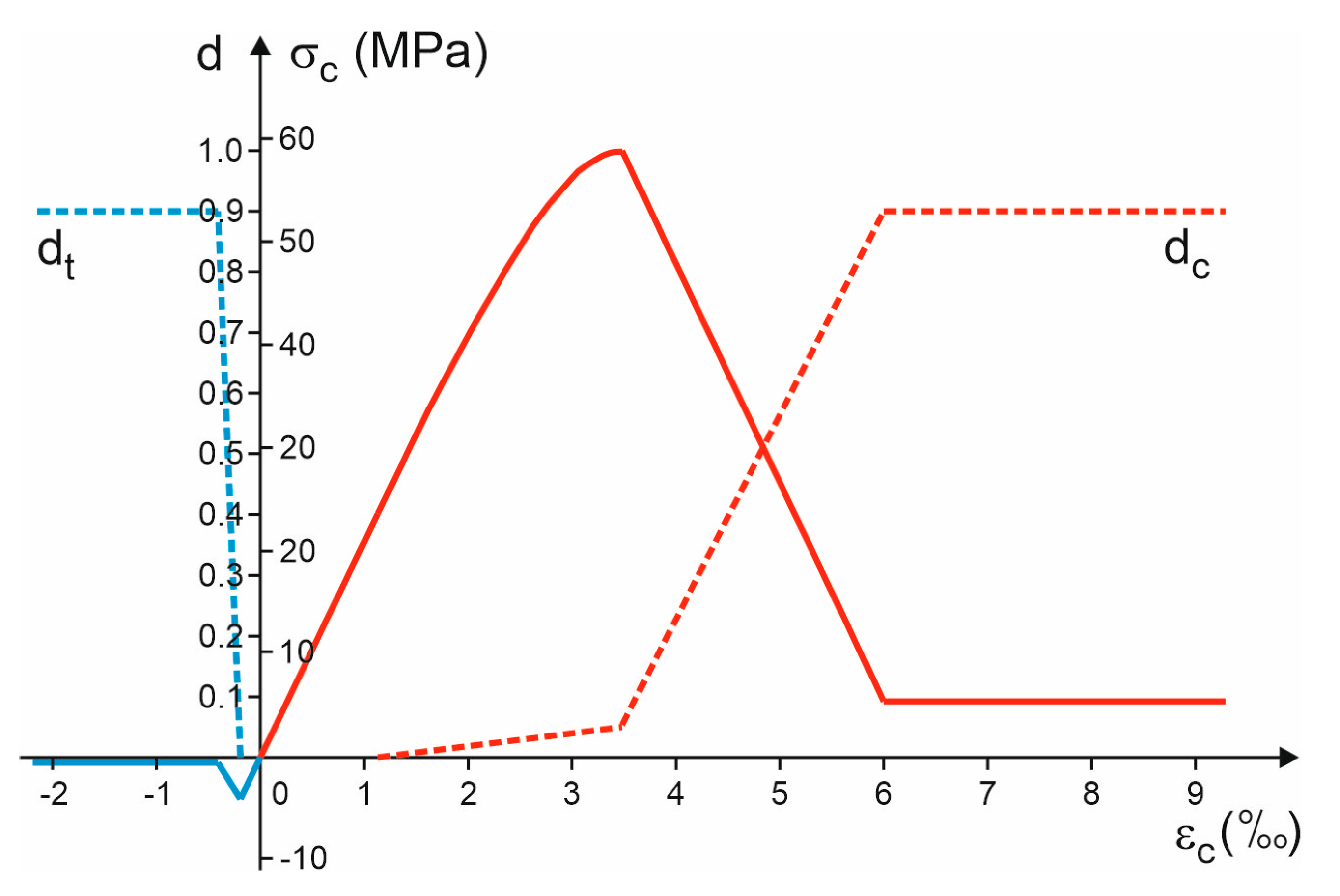

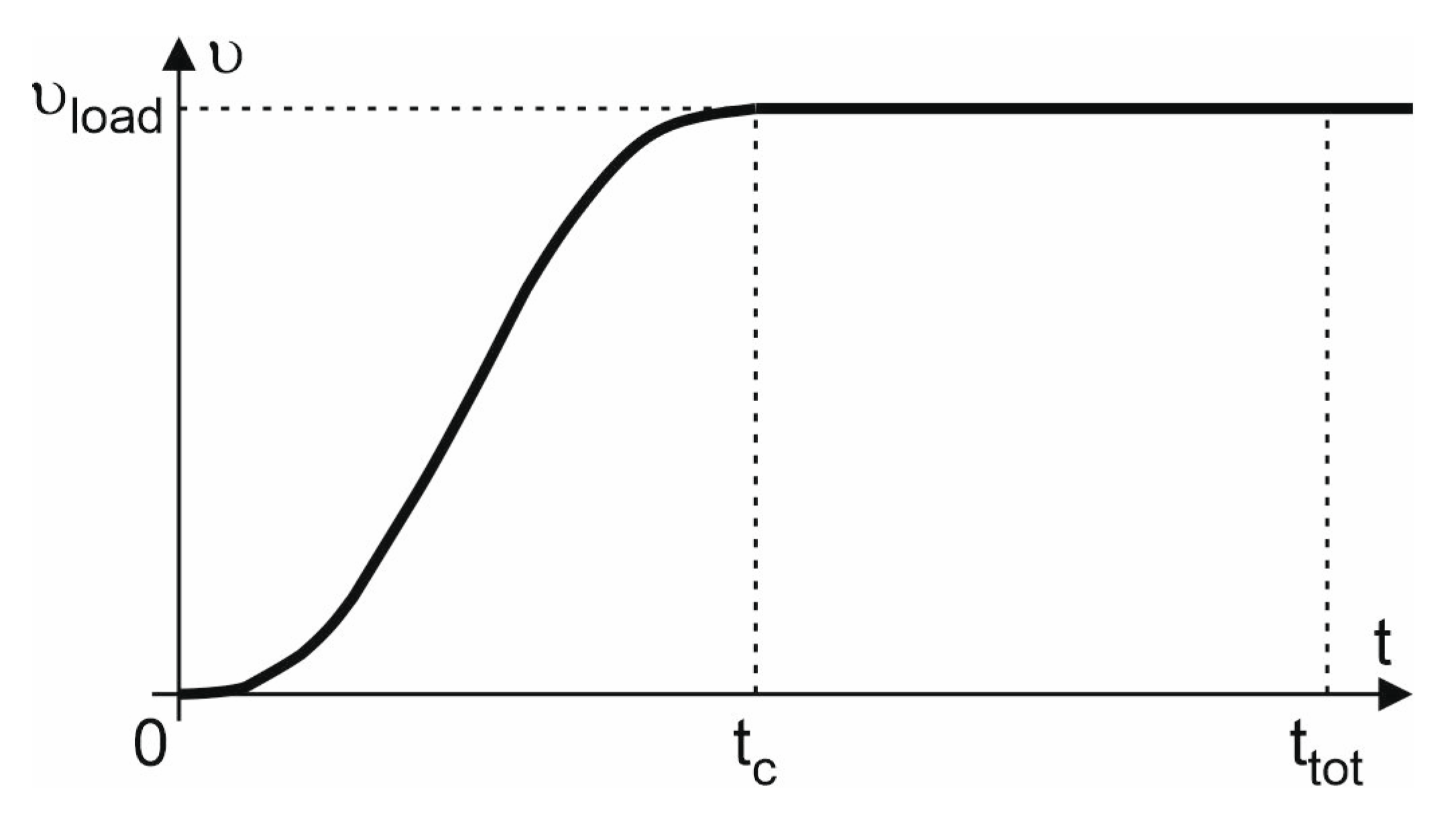
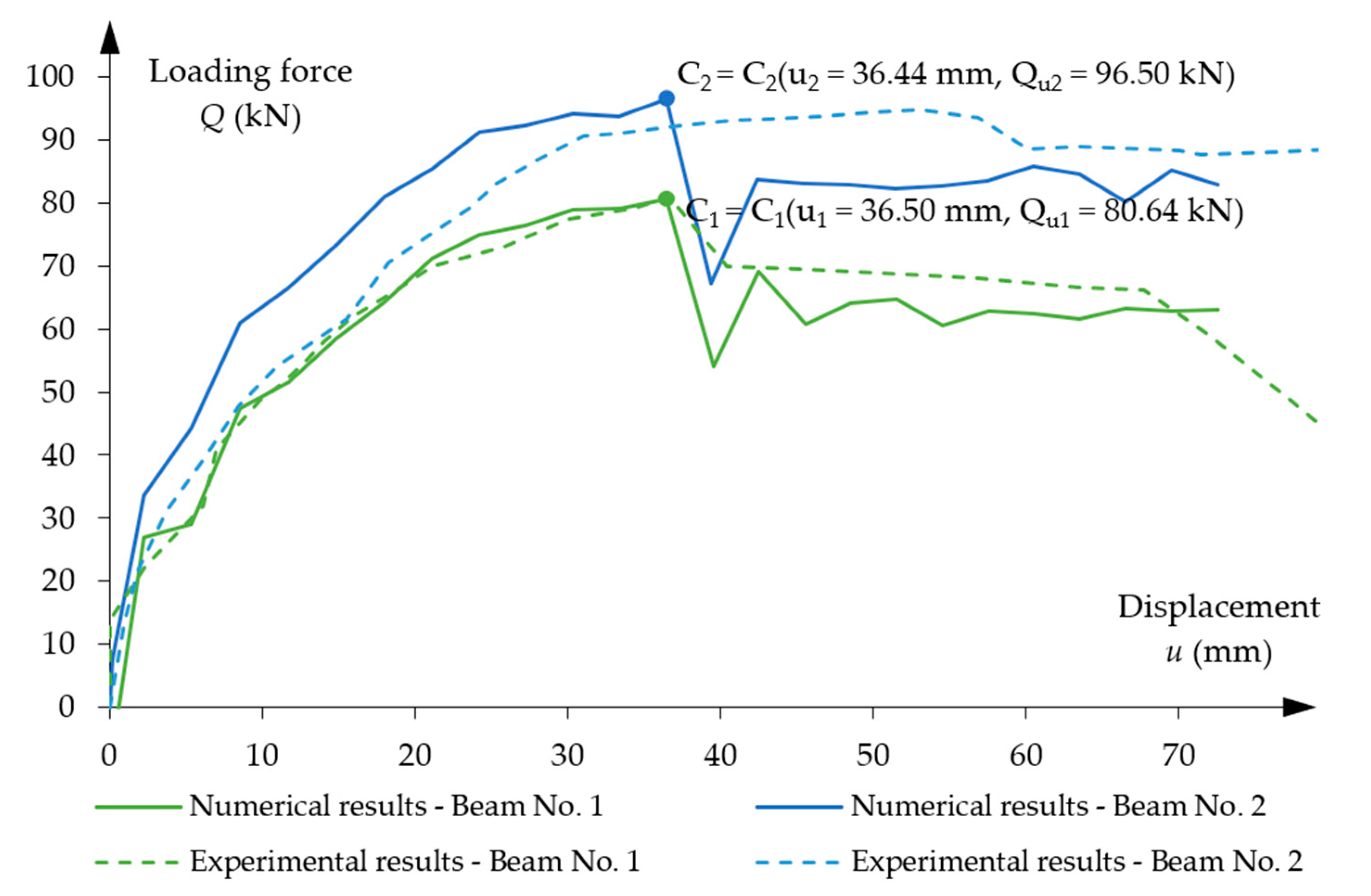
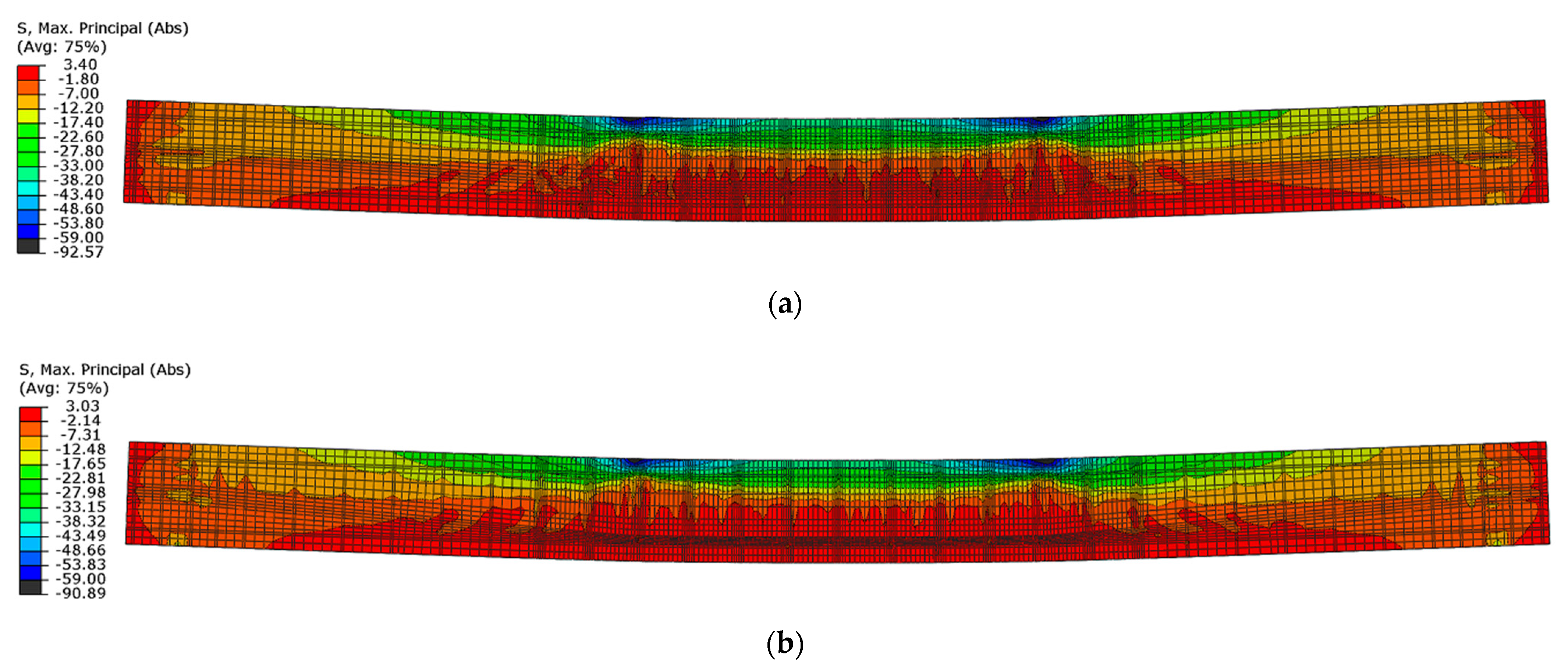

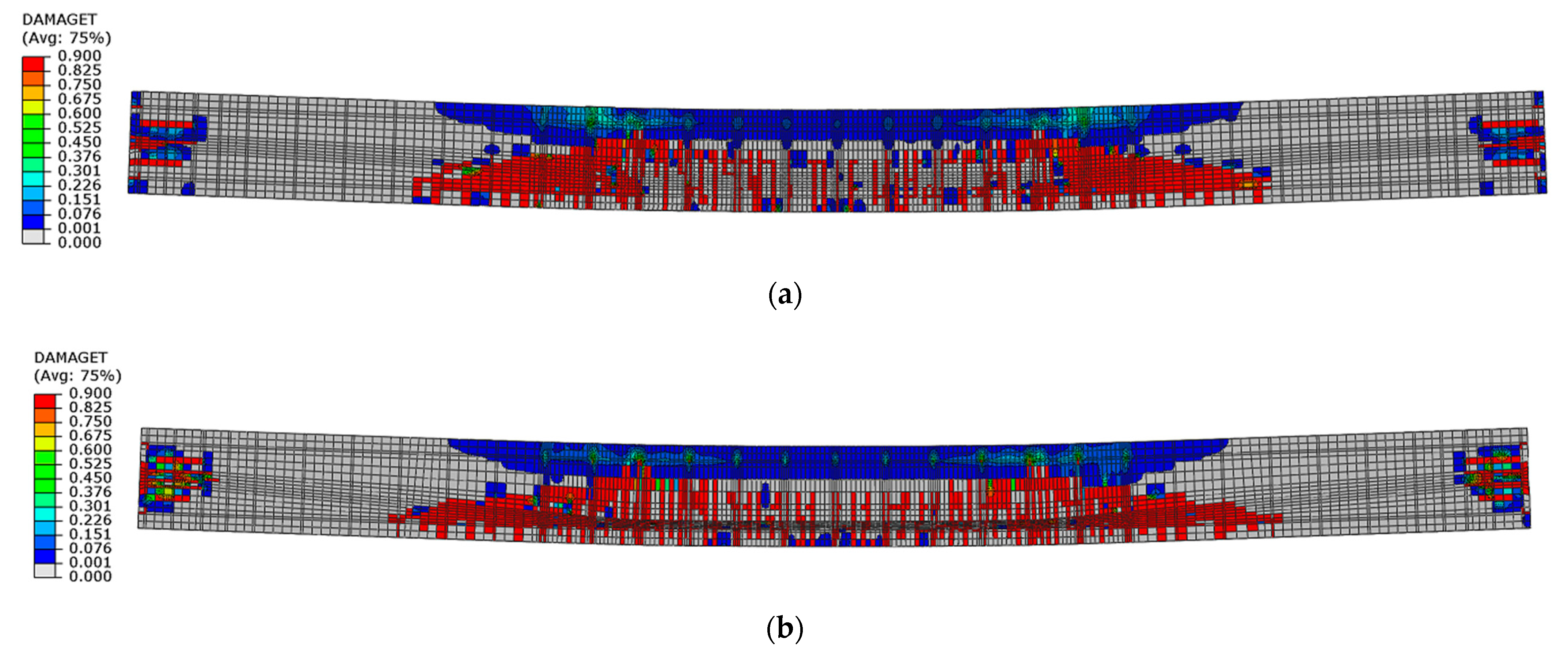
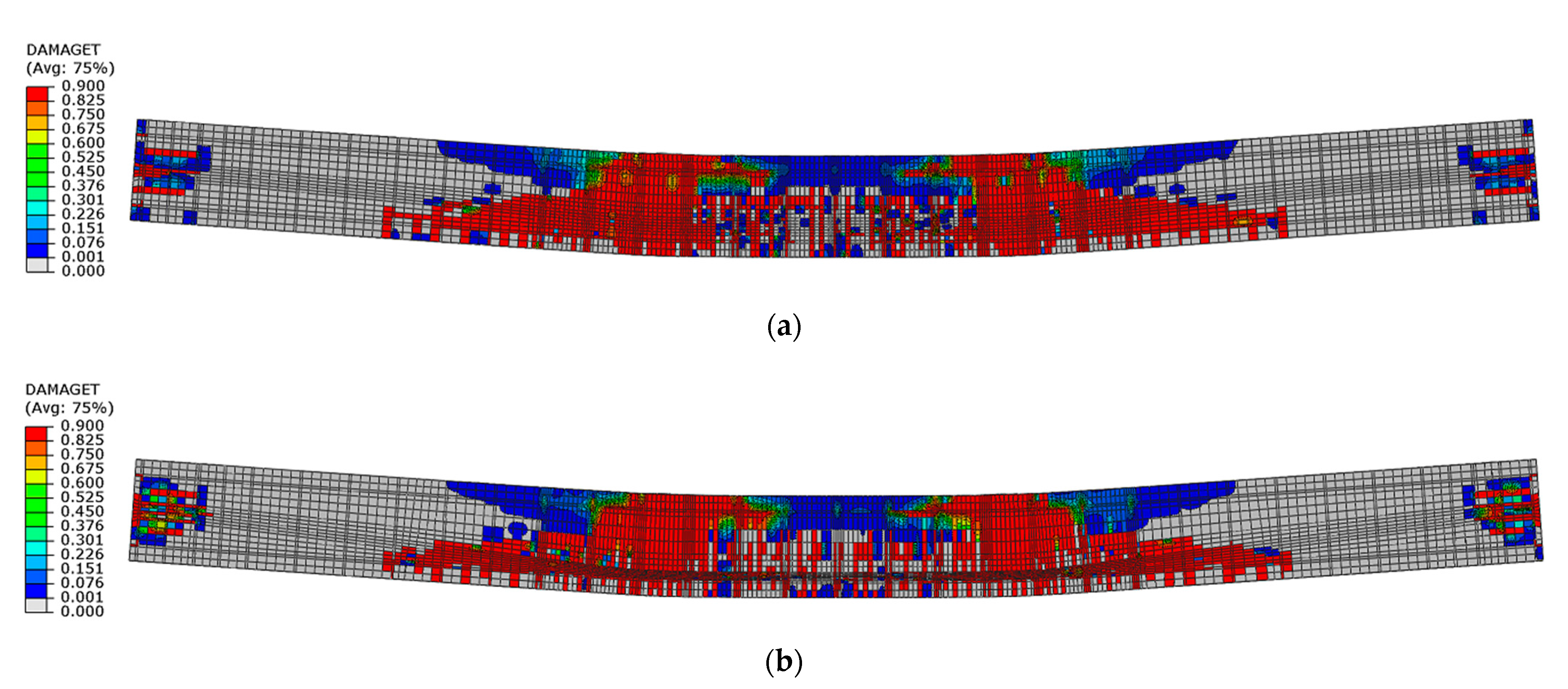
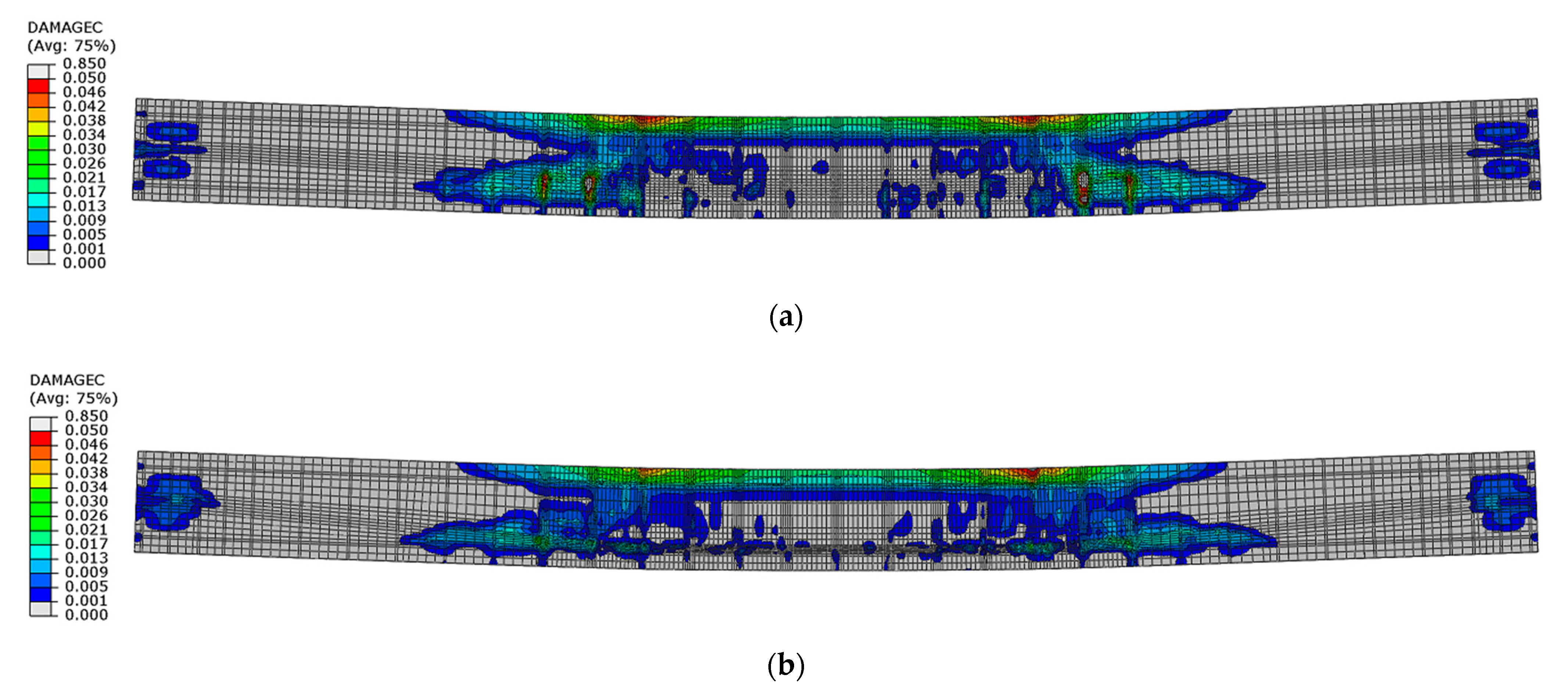
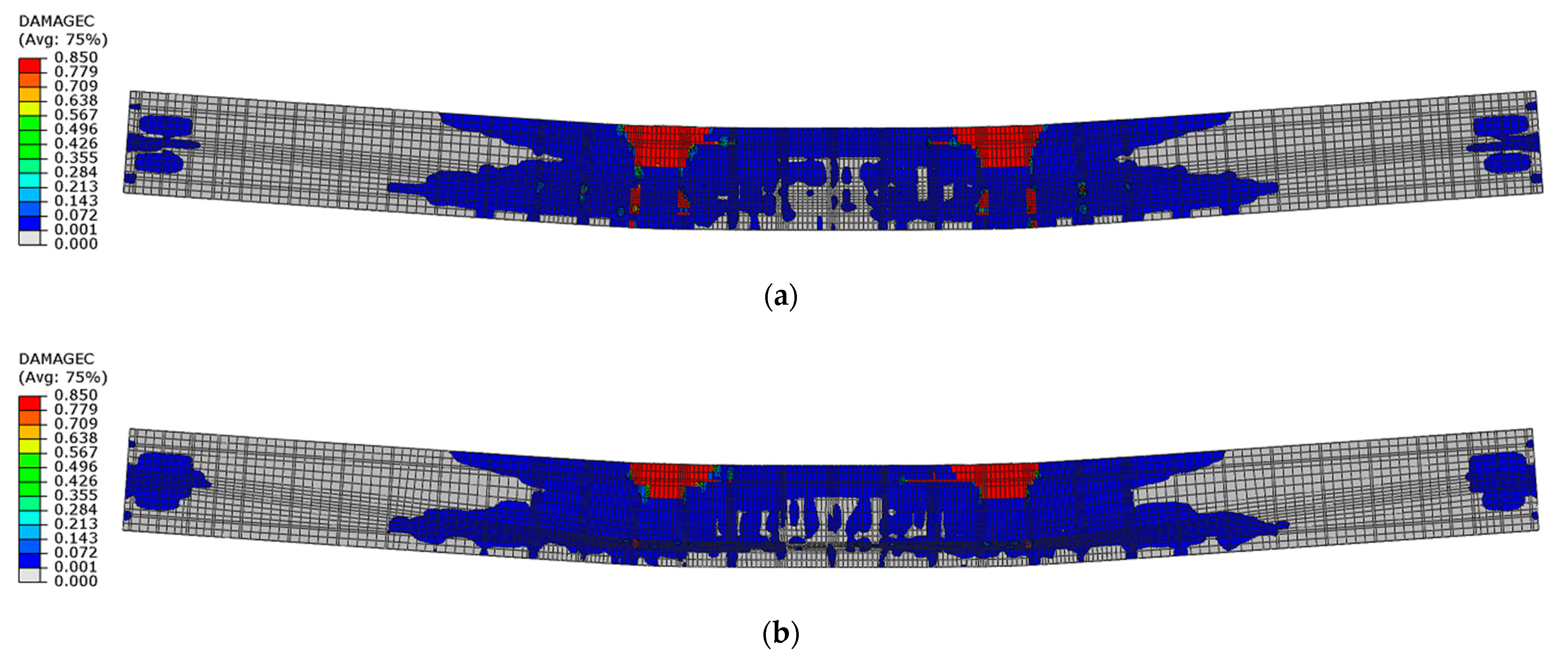
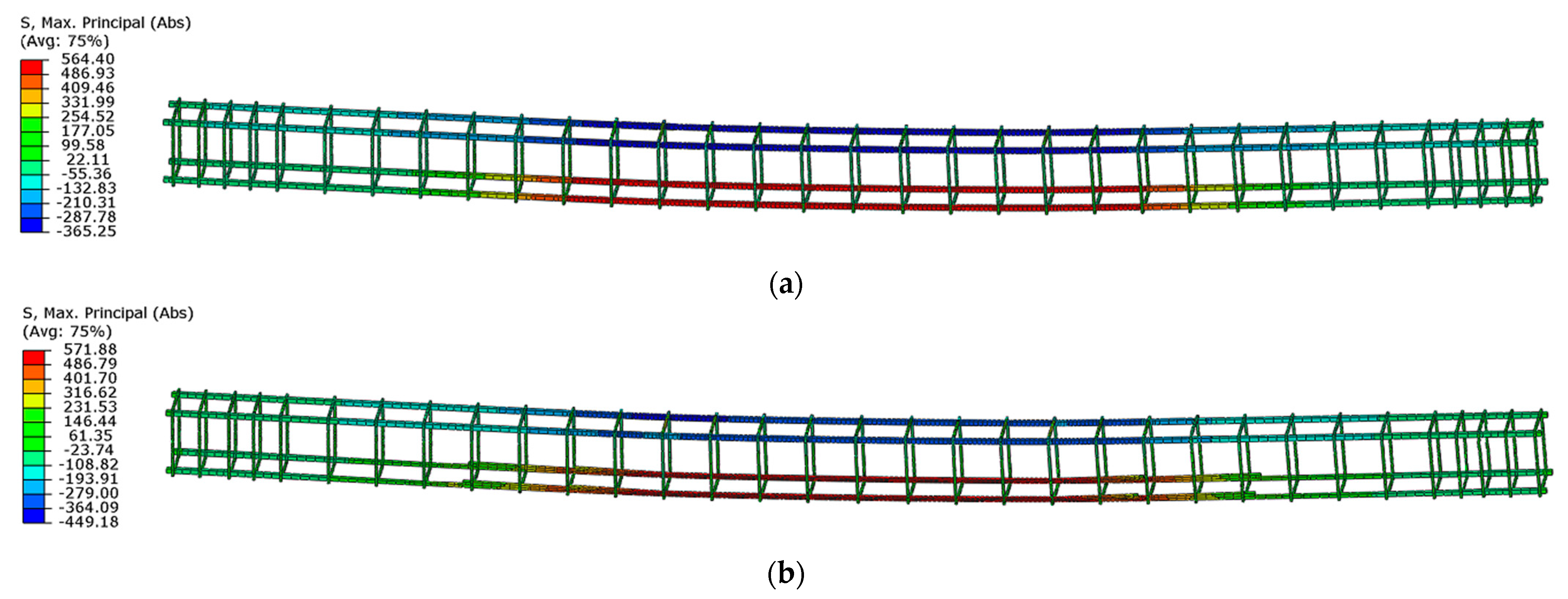
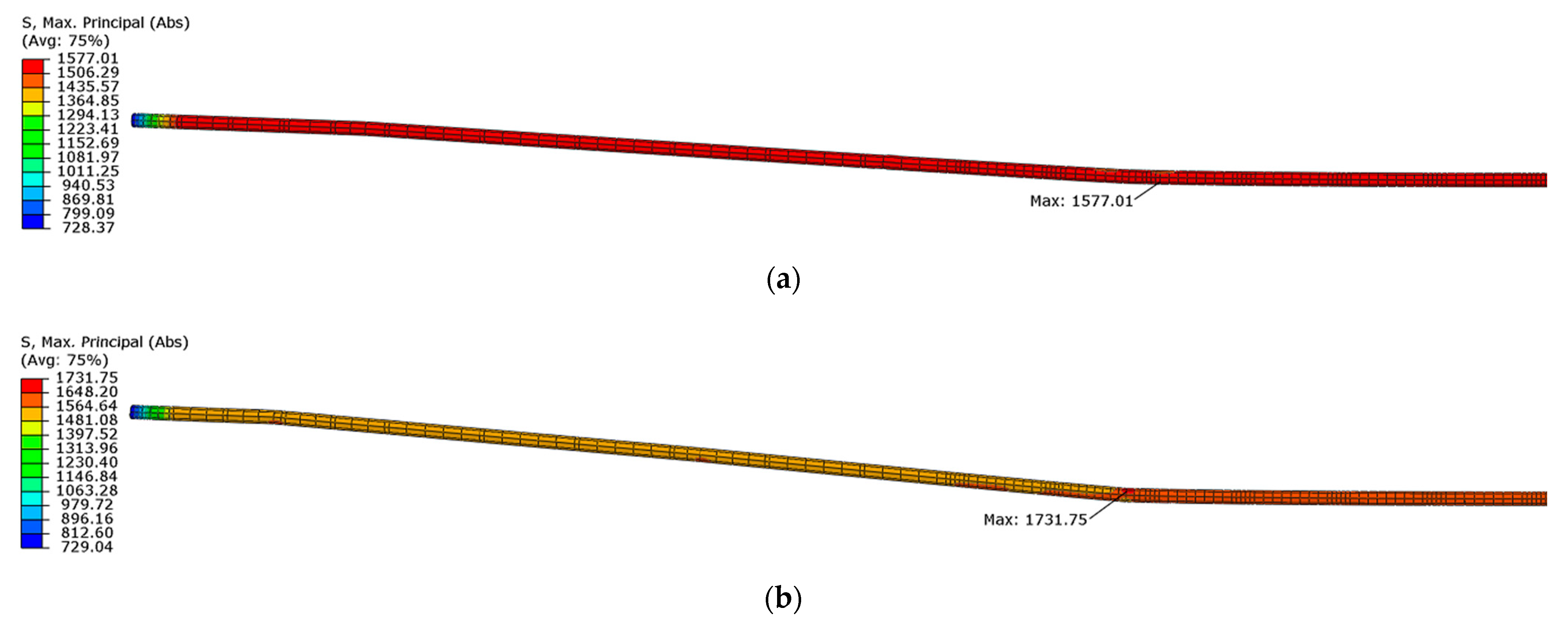
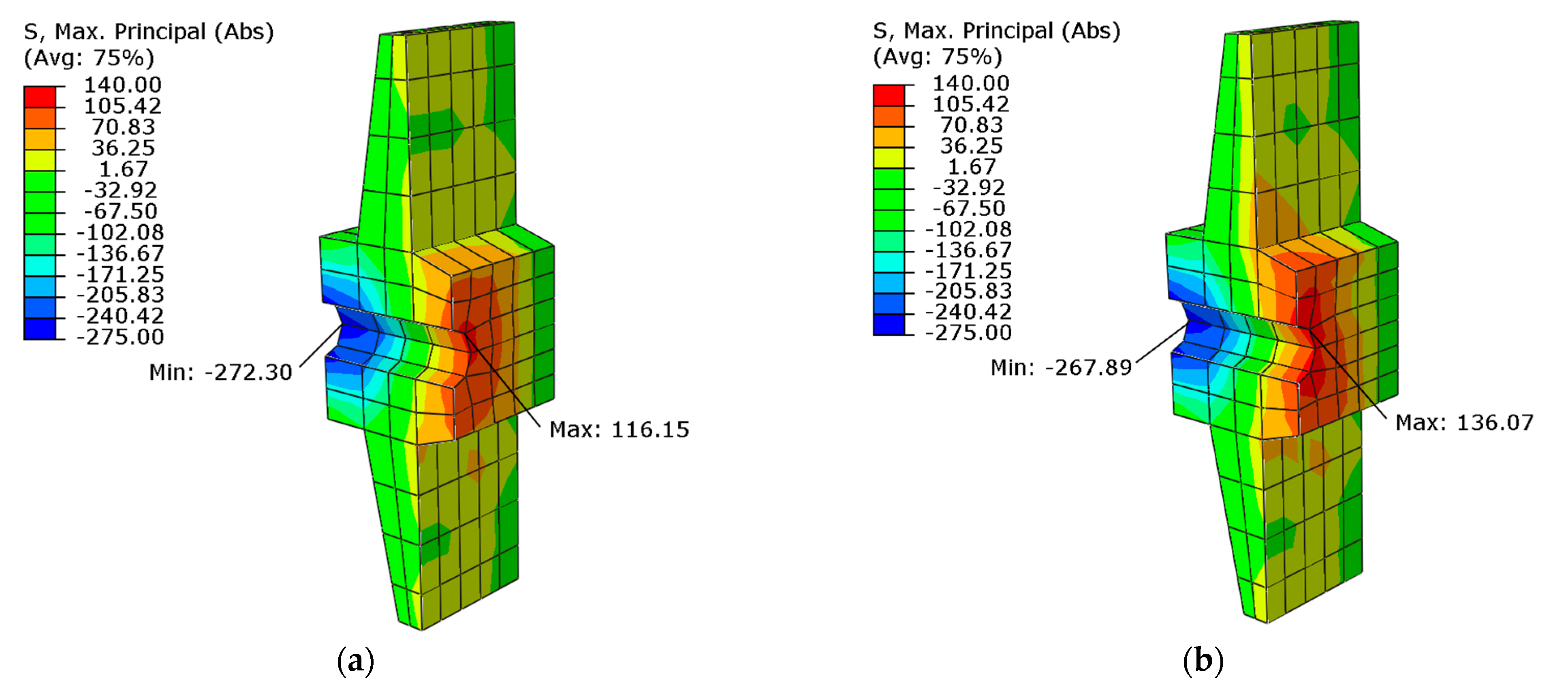
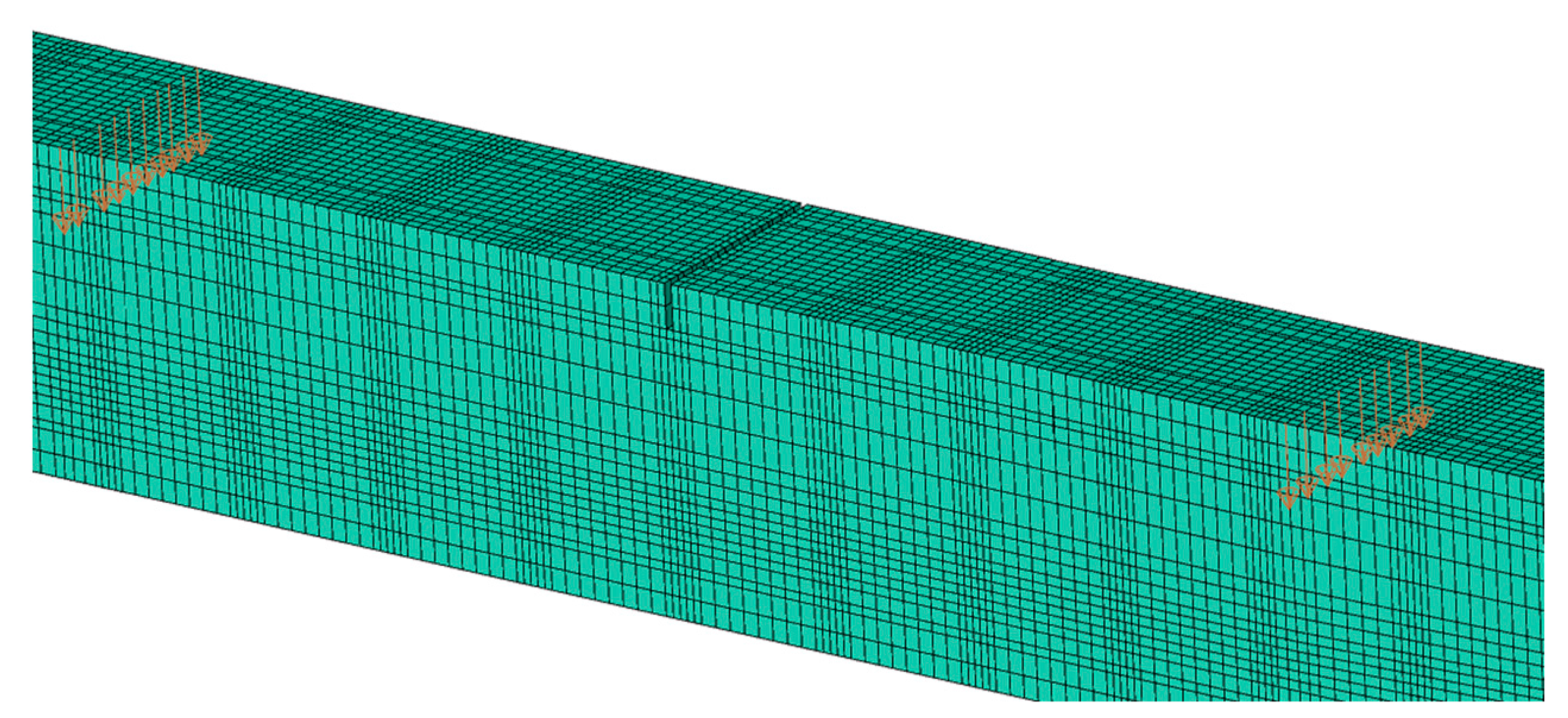




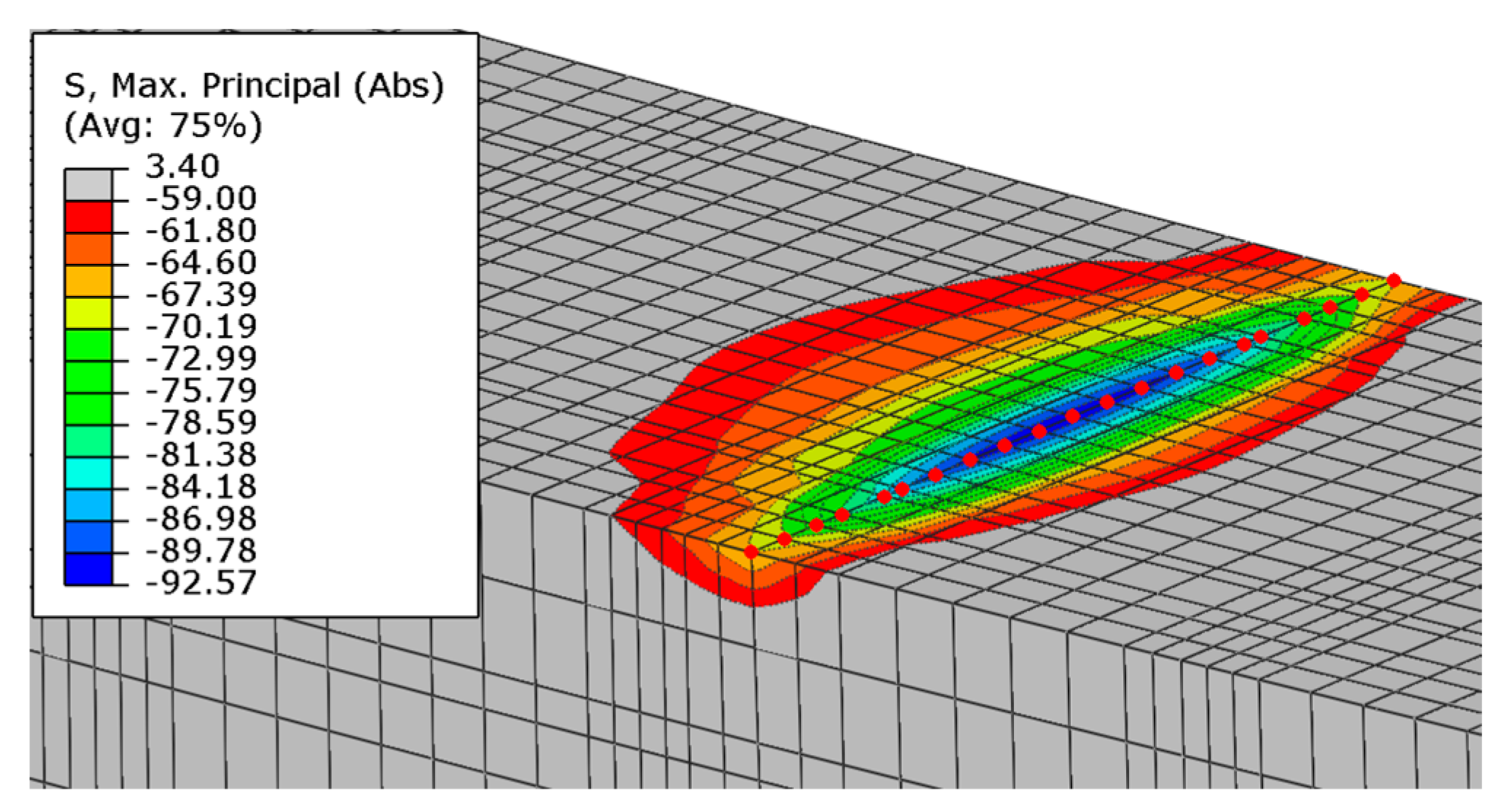
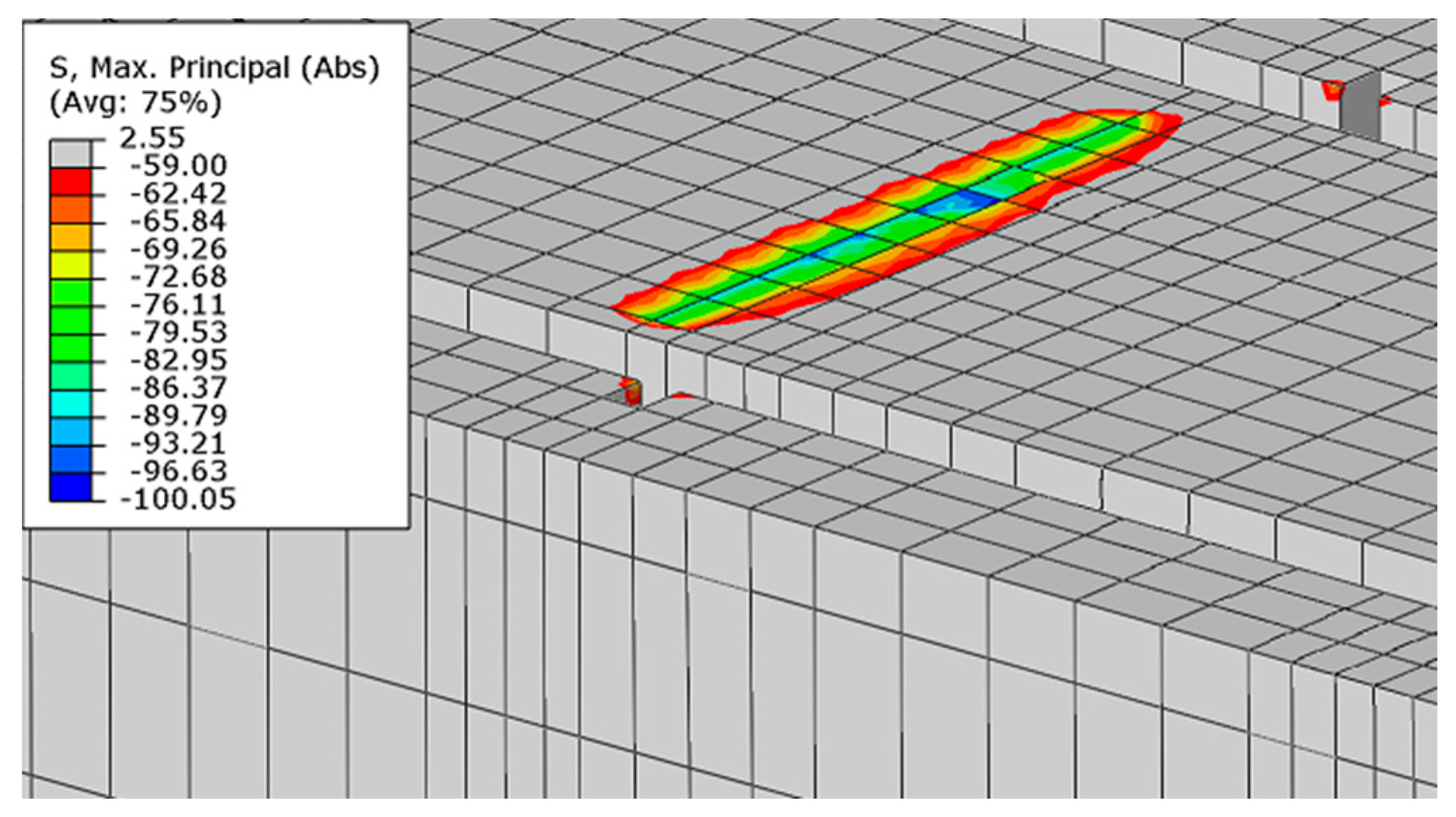
| Age of Concrete (Days) | Sample No. | Cube Compressive Strength | Cube Mean Compressive Strength | Concrete Density (kg/m3) |
|---|---|---|---|---|
| 28 | 1 | 57.7 | 58.1 | 2320 |
| 2 | 58.4 | |||
| 45 | 1 | 60.1 | 61.4 | |
| 2 | 62.7 | |||
| 3 | 61.4 |
| Sample No. | Bar Section Area (mm2) | (MPa) | (MPa) | (MPa) | (MPa) | (GPa) | (GPa) | (%) | (%) |
|---|---|---|---|---|---|---|---|---|---|
| 1 | 20.83 | 1802.00 | 1816.03 | 1944.07 | 1949.47 | 212.00 | 213.65 | 2.80 | 2.87 |
| 2 | 20.83 | 1807.70 | 1946.72 | 212.67 | 2.80 | ||||
| 3 | 20.83 | 1838.38 | 1957.62 | 216.28 | 3.00 |
| Type of Bar | Bar Section Diameter | Yield Limit | Tensile Strength |
|---|---|---|---|
| Longitudinal bars | 10 | 540 | 615 |
| Stirrups | 6 | 532 | 620 |
| Characteristic Point No. | Stress (MPa) | Strain |
|---|---|---|
| 1 | 1424.06 | 0.007 |
| 2 | 1816.03 | 0.010 |
| 3 | 1878.67 | 0.012 |
| 4 | 1949.47 | 0.0287 |
| Type of Component | Modulus of Elasticity (MPa) | Yield Strength (MPa) | Elastic Strains | Ultimate Tensile Strength (MPa) | Ultimate Strains |
|---|---|---|---|---|---|
| Rebar H6 | 210,000 | 532 * | 0.00253 | 620 * | 0.08 |
| Rebar H10 | 210,000 | 541 * | 0.00258 | 615 * | 0.08 |
| Anchorage | 200,000 | 430 | 0.00215 | 700 | 0.16 |
| Parameter | (°) | ||||
|---|---|---|---|---|---|
| Value | 56.3 range: [10; 56.3] | 0.1 range: [0.1; 1.0] | 1.16 | 0.677 range: [0.5; 1.0] | 0 |
| Parameter | Value |
|---|---|
| 59.0 MPa | |
| 4.095 MPa | |
| 21.05 GPa | |
| 0.4 | |
| 0.1 | |
| 0.1 | |
| 3.45‰ | |
| 0.19‰ | |
| ‰ | 6.0 |
| ‰ | 0.42‰ |
Disclaimer/Publisher’s Note: The statements, opinions and data contained in all publications are solely those of the individual author(s) and contributor(s) and not of MDPI and/or the editor(s). MDPI and/or the editor(s) disclaim responsibility for any injury to people or property resulting from any ideas, methods, instructions or products referred to in the content. |
© 2023 by the authors. Licensee MDPI, Basel, Switzerland. This article is an open access article distributed under the terms and conditions of the Creative Commons Attribution (CC BY) license (https://creativecommons.org/licenses/by/4.0/).
Share and Cite
Jancy, A.; Stolarski, A.; Zychowicz, J. Experimental and Numerical Research of Post-Tensioned Concrete Beams. Materials 2023, 16, 4141. https://doi.org/10.3390/ma16114141
Jancy A, Stolarski A, Zychowicz J. Experimental and Numerical Research of Post-Tensioned Concrete Beams. Materials. 2023; 16(11):4141. https://doi.org/10.3390/ma16114141
Chicago/Turabian StyleJancy, Anna, Adam Stolarski, and Jacek Zychowicz. 2023. "Experimental and Numerical Research of Post-Tensioned Concrete Beams" Materials 16, no. 11: 4141. https://doi.org/10.3390/ma16114141







